|
M83 - The Southern Pinwheel = NGC 5236 (see
the wikipedia
definition and NED entry and Simbad entry)
TOC:
Basic parameters (go to top)
Contellation: Hydra
RA = 13h 37m 00.9s (from NED)
DEC = −29°51′57″ (from NED)
Redshift = 513 ± 2 km/s (from NED)
Distance = 4.61Mpc (15.21 Mly) (Saha et al. 2006ApJS..165..108S)
P.A. = 45 deg (Comte et al. 1981A&AS...44..441C)
Inclination angle = 24 deg (Talbot et al. 1979ApJ...229...91T)
Type = SAB(s)c (from NED)
Vsys = 506 km/s (optical, Thim et al. 2003ApJ...590..256T) or 512 +-0.7 km/s (CO 1-0 & 2-1, Lundgren et al., 2004A&A...422..865L)
V band apparant size = 12'.9 × 11'.5 (from NED)
Holmberg diameter D0 = 14'.6 (= 19.2 kpc at Dist of 4.5 Mpc, Huchtmeier & Bohnenstengel 1981A&A...100...72H)
H2 gas disk scale length Rd = 2.8 +-0.22 kpc (CO 1-0 & 2-1, Lundgren et al., 2004A&A...422..865L)
Corotation radius (CR) ≈170" (3.7 kpc, Lundgren et al., 2004A&A...422..865L)
Outer ultraharmmonic radius (oUHR) ≈240" (5.2 kpc, Lundgren et al., 2004A&A...422..865L)
Outer
Lindblad resonance (OLR) ≈290" (6.3 kpc, Lundgren et al., 2004A&A...422..865L)
Inner
Lindblad resonance (ILR) was not seen in CO 1-0 and 2-1 maps (6.3 kpc, Lundgren et al., 2004A&A...422..865L)
Pattern speed Ωp = 47 km/s/kpc (the same for both the bar and the spirals, ???)
V band magnitude = 7.54 (from Simbad and Armando et al. 2007ApJS..173..185G)
Supernovae observed = SN 1923A, SN 1945B, SN 1950B, SN 1957D, SN 1968L and SN 1983N
Neighbourhood = Center of the M83 sub-cluster < Cent A/M83 Group < Virgo surper-cluster (or local super-cluster):
(click to enlarge: the neighbourhood of M83 as projected on the suer-galactic plane, from Wikipedia)
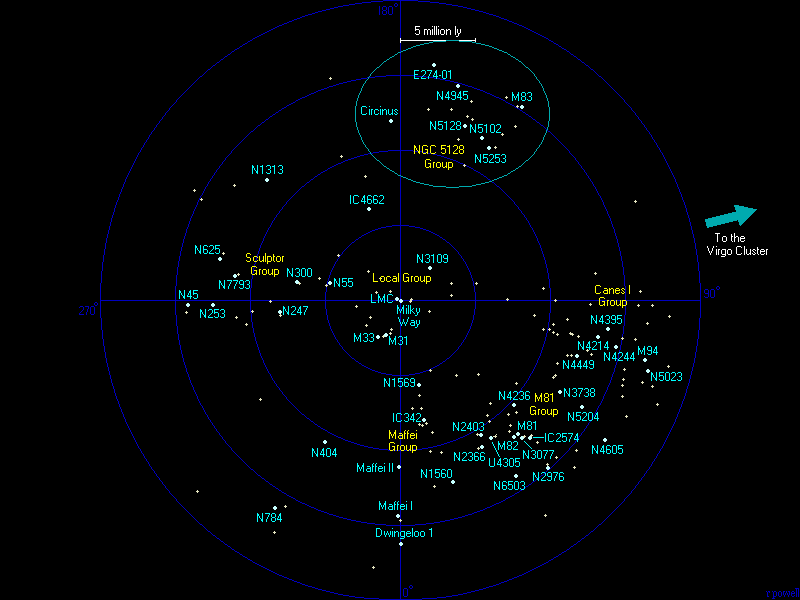
Mass:
-- dynamical mass Md = 6e+10 Msun (Lundgren et al. 2004A&A...422..865L estimated the dynamical mass from rotation curve for a distance of 4.5 Mpc)
-- HI mass = 7.8e+9 Msun (Huchtmeier & Bohnenstengel 1981A&A...100...72H determined measured a total HI mass of about 1.9x10^10 Msun in their Table 1 for a distance of 8.9 Mpc, which can be scaled to this value for a distance of 4.5 Mpc)
-- H2 mass = 4e+8 Msun (Lundgren et al. 2004A&A...413..505L measure the H2 mass for a distance of 4.5 Mpc)
-- Dust mass = 4e+8 Msun (Folye et al. 2012MNRAS.421.2917F found the total dust mass for a distance of 4.5 Mpc)
Metallicity:
-- log-linearly decreases from 12+log(O/H) = 8.9 (2 x solar) near the center to 12+log(O/H) = 8.0 (1/5 x solar) for the radii around 1.5–2.0 R25. (Ferguson et al. 1998AJ....116..673F found it in the inner disk of M83 by optical spectroscopy of HII regions, which is confirmed by Gazak et al. 2014ApJ...787..142G who measured a disk metallicity of [Z] = +0.28 ± 0.14 dex (1.9 x solar) using a moderate resolution R ~ 3500 VLT J-band spectrum of a super star cluster in M83 and their new method.)
-- flattens out to a large radius of about 22.3 kpc beyond the break at a radius of around R25=8.4 kpc, with the values varying between 1/3 and 1.0 times of solar metallicity (Bresolin et al. 2009ApJ...695..580B found it in the outer disk by observing optical spectra of 49 HII regions. They also confirmed the metallicity trend in the inner disk as found by Ferguson et al. 1998AJ....116..673F)
Optical observations of M83 (go to top)
- (Talbot et al. 1979ApJ...229...91T)
Facts: They made UBVR photometry and found no systematic color gradient within spiral arms and no significant color gradients behind the arms in those regions completely free of stars less than 50 million years old.
Conclusions: The results support the noncircular orbits and imperfect synchrony of star formation as the expectations from density-wave theory.
Millimeter observations of M83 (go to top)
- Lundgren et al., 2004A&A...413..505L
Facts:They mapped M83 in CO 1-0 (45", or 980 pc resolution) and 2-1 (23" or 500 pc resolution) lines using SEST. CO maps are compared with that in other wavelengths.
Conclusions:
The CO mass a similar as in other wavelengths, including star formation tracers. The CO 2-1/1-0 intensity ratios are 0.77 on average, smaller in arms and larger in inter-arm regions. Arm-interarm CO 1-0 intensity contrast is 2.5. Within radius 7.3 kpc, the H2 mass is about 2 times HI mass. The gas/star mass ratio is 0.1 in the optical disk. Scale length of the H2 gas disk is 120" or 2.6 kpc.
(Figs: left -- I(CO 1-0) over B,V,R RGB-map; left middle -- I(CO 2-1) over Halpha,I,V-I RGB-map; right middle -- I(CO 1-0) over HI map; right -- I(CO 2-1) over HI map;
bottom -- CO 2-1/1-0 intensity ratios, left is for inter-arm regions, right is for all disk regions.)
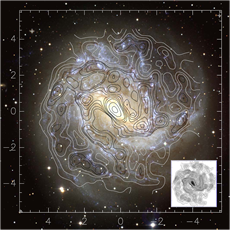 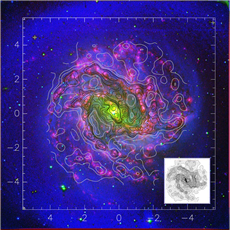 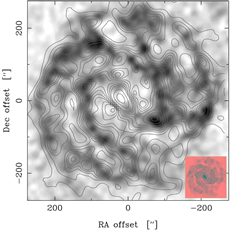 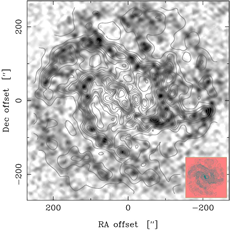
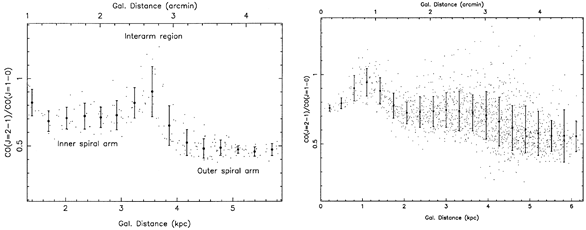
- Lundgren et al., 2004A&A...422..865L
Facts:They analysed the molecular gas kinematics using the CO 1-0 and 2-1 lines mapping of M83 with SEST. Iso-velocity maps are produced for the 10' x 10' entire optic disk.
Results: They found the pattern of an inclined, rotating disk, but also the effects
of streaming motions along the spiral arms.
Conclusions:
Its dynamic mass is 6x10^10 Msun. Gas constitutes 13% of the total mass. The pattern speed is determined
from the residual velocity pattern. ...
|
![]()